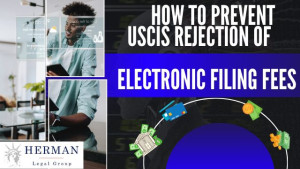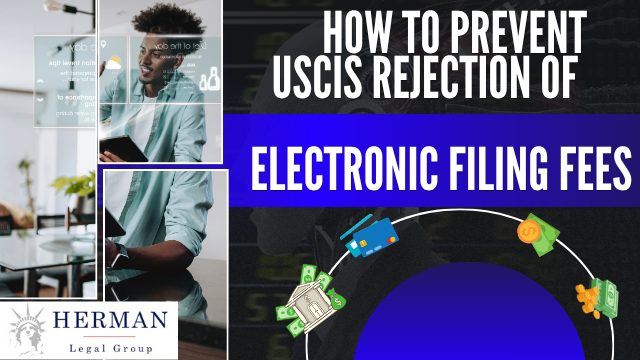Introduction
Beginning October 28, 2025, USCIS will require only electronic payments for paper-filed forms—including via credit/debit card (Form G-1450) or ACH debit (Form G-1650). This change implements the federal directive under Executive Order 14247 (“Modernizing Payments To and From America’s Bank Account”).
Why this matters:
If your payment is rejected by USCIS, your entire application or petition can be rejected or delayed—even if your eligibility is otherwise solid. As immigration attorney Richard T. Herman of the Cleveland-based Herman Legal Group explains:
“This shift streamlines government efficiency but introduces new liability for immigrants and lawyers who make innocent payment errors.”
In this article you’ll find:
- What changed & why
- Which payment methods and forms are accepted
- Top reasons for payment rejections
- A detailed checklist for success
- What happens if a payment fails
- Expert input and comparison of regional law firms
- An expanded FAQ section
- Key Takeaways to close

1. What Changed: USCIS’s Mandatory Electronic Payment Rule
Effective October 28, 2025, USCIS will only accept electronic payments (credit/debit or ACH) for applications, petitions or requests filed on paper. Previously, applicants could submit checks or money orders with paper-filed forms. This policy change is part of USCIS’s effort to modernize its payment systems to reduce fraud and improve processing efficiency.
This policy shift tracks Executive Order 14247, which mandates that federal agencies move away from paper-based payments and embrace secure electronic payment systems to reduce delays, fraud and lost payments.
USCIS states that the continued use of checks and money orders “imposes unnecessary costs; delays; and risks of fraud, lost payments, theft, and inefficiencies.”
Although online filings already accept e-payments, the key area of risk now is paper-filed forms where the applicant must still affix a payment authorization form (G-1450 or G-1650) and ensure the payment clears. For anyone filing in 2025 and beyond, the payment step has become a critical compliance piece — not just the form content itself. USCIS will reject your application if the card is declined and will not attempt to process the payment again.
2. Accepted USCIS Payment Methods (2025 Update)
Here’s a breakdown of the approved payment methods under the new regime:
Credit or Debit Card → Form G-1450
Use the authorization form Form G-1450: Authorization for Credit Card Transactions.
USCIS’s “Pay With a Credit Card by Mail” page confirms: you may pay your filing fee and any biometric services fee via a U.S.-issued credit or debit card (Visa, MasterCard, AmEx, Discover). USCIS accepts credit card payments from major networks like Visa, Mastercard, American Express, and Discover.
Important: The card must be issued by a U.S. bank. USCIS “cannot accept a credit card issued by a foreign bank.”
Also, USCIS imposes a daily transaction limit of $24,999.99 per credit card per day. (Check USCIS website for current limits.)
ACH Debit from U.S. Bank Account → Form G-1650
Use Form G-1650: Authorization for ACH Transactions (check the edition date). This allows USCIS to debit your bank account directly.
Make sure your bank account is located in the U.S. and permitted to receive government ACH debits.
Online Filing via Pay.gov
If filing online through the USCIS portal, payment is processed via the Pay.gov platform, which the U.S. Department of the Treasury provides for federal payments.
USCIS’s “Filing Fees” page reinforces that when you file online, the system directs you through Pay.gov for card or bank payment. Only make payments through the official USCIS online filing system which directs to the U.S. Department of Treasury’s Pay.gov website.
Exemptions / Special Cases
Some very limited circumstances allow paper payments. See Form G-1651: Exemption for Paper Fee Payment for details on who qualifies. USCIS recommends submitting separate payments for each benefit request to avoid processing issues.
In general, however, most regular family-based, employment-based or humanitarian filings will fall under the new electronic-payment requirement.
3. Top Reasons USCIS Rejects Electronic Payments
Understanding common failure points helps you prevent them. Here are major causes of payment rejection: Each filing fee should ideally be paid separately to avoid rejection of the entire package if one form is defective.
- Typographical errors: incorrect card number, expiration date or CVV will cause automatic decline.
- Expired card or insufficient credit limit: large government payments may trigger issuer blocks or fraud flags.
- Insufficient funds / bank refuses ACH: if you choose ACH and your account lacks funds or the bank rejects the debit, your payment fails.
- Name or billing address mismatch: If the name or address you entered on Form G-1450 doesn’t exactly match the billing records of the card or bank account, the payment may be declined.
- Bank blocks government or international payments: Some banks treat government ACH or large card payments as high-risk and auto-decline them.
- Using outdated form edition / signature missing: If you fail to use the correct version of Form G-1450 or G-1650 with a valid signature/date, the payment may be rejected.
- Using a card issued outside the U.S.: USCIS explicitly disallows non-U.S.-bank issued cards for G-1450 payments.
- Splitting payments incorrectly: If you attempt to pay one filing fee by splitting across two cards but did not submit two properly completed G-1450 forms (one for each card) that add up correctly, USCIS may reject it.
- Bank fraud flag/block: Even if you did everything right, your bank may block the charge as suspicious or unusual.
In one Reddit thread, a user commented:
“I called the credit card company and notified them of a big upcoming charge. Chase said it wouldn’t have been declined but added the expected charge range into the system and my charge went through as expected.”
These stories show the importance of advance notification to card issuers.
4. Step-by-Step Checklist: How to Ensure Your Payment Goes Through
Use this checklist to systematically prepare your payment and minimize risk:
- Download the correct, current edition of Form G-1450 (credit card) or Form G-1650 (ACH). Verify edition date.
- Fill out the applicant/petitioner information exactly as it appears on your bank/card record (name, mailing address, etc.).
- Use a U.S.-issued card or U.S. bank account only. Non-U.S. cards are likely to be declined.
- Notify your bank or card issuer ahead of time that you intend to make a significant government payment to USCIS. Ask them to whitelist the merchant or transaction.
- Ensure funds or credit limit are sufficient, plus buffer in case of holds or pre-authorization.
- Double-check billing address, ZIP code and name for exact match with banking records.
- If splitting payment among cards, submit one Form G-1450 per card and ensure the sum equals the exact fee amount.
- Sign and date the authorization form (black ink if paper) in the right section.
- Attach the authorization form properly to your filing package—place G-1450 on top of your application/petition when mailing.
- Retain a copy of the payment form and payment attempt screenshot or receipt, for your records.
- Avoid using prepaid/shared/corporate cards unless you are certain the cardholder name matches the filing name and the bank permits such usage.
- After submission, check your bank or card statement within 48-72 hours to confirm authorization or charge.
- Monitor your mailbox or USCIS online account for a payment acceptance notice or any rejection notice.
- If your filing is time-sensitive, submit earlier than usual to allow buffer for any payment issues.
- Keep documentation of your filing date and payment attempt in case you must re-file.
Following these steps significantly lowers the risk that your filing will be rejected solely because of a payment failure.
5. What Happens If Your Payment Fails
Understanding the consequences and your options helps you act quickly:
- Filing may be rejected or returned: If USCIS cannot charge your payment method, your application or petition may be rejected for “lack of payment” or returned un-adjudicated.
- Loss of priority date or filing window: In many immigration processes (especially employment-based, cap-subject filings, premium processing), a missed payment means you lose your slot and may suffer delays or have to wait again.
- Need to resubmit payment and filing: You may have to fix the payment method (new card/account), complete a new payment authorization form, and re-file the application—with associated costs and delays.
- Fee may not be refunded: If your payment cleared but the filing is later rejected for another reason, you may not get a refund. If payment did not clear and filing is rejected, you still must re-pay.
- Legal risk for counsel: For law firms, a payment error that leads to rejection may expose the client to harm and the firm to reputational or malpractice risk.
Richard T. Herman warns:
“When a filing fails simply because payment was rejected, the immigrant’s case is penalized even though they did everything else correctly — it’s an avoidable trap.”
What to do if payment fails:
Immediately contact your bank or card issuer to learn the reason for decline.
- Notify your attorney that payment failed and check whether the filing needs to be re-submitted.
- Preserve any proof that you attempted submission on time (tracking, courier date, screenshots) in case the filing deadline is impacted.
- Consider switching payment method (for example, from card to ACH) if the issuer places repeated blocks.
- Keep all correspondence and evidence of payment attempt and decline in your file.
While a single payment rejection is not always fatal, it does require timely remedial action to avoid serious delay or loss of benefit. Save or download the payment confirmation receipt after successful payment.
6. Expert Commentary: Richard T. Herman on USCIS Modernization
“This electronic-payment shift is long overdue from a government-efficiency perspective—but for immigrants and counsel it is new liability. One small typo on a G-1450 or an unannounced card block can turn a meritorious case into a refund request,” advises veteran immigration attorney richard t. herman.
With over 30 years in immigration law, Herman emphasizes that the payments process is now part of the filing compliance — not just the case merits. He advises:
Maintain a dedicated payment account for USCIS filings, separate from general household or corporate credit usage, to eliminate confusion or decline risk.
- Counsel should build internal check-lists that cover payment method verification, bank/card advance notification, form edition/date audit, billing info match, funds availability, and post-submission verification tracking.
- For time-sensitive filings (e.g., premium processing, cap filings), the payment step can decide whether the filing truly “counts.”
Herman’s firm now audits every fee payment one week before submission to catch issues proactively.
“Client payment mistakes are a top risk for rejection under the new rule — our firm now audits every fee payment the week before submission, so we can intervene if bank issues arise, says Richard Herman.
If you’re working with Ohio-based counsel (Cleveland/Columbus/Akron/Dayton/Cincinnati/Youngstown) or elsewhere, ask how your law firm monitors the payment step and what backup plan they have for rejected payments.
7. Comparison: Leading Immigration Law Firms in Ohio
Here are several reputable Ohio-based immigration law firms that handle USCIS filings and can assist with payment compliance:
- Herman Legal Group (Cleveland / Columbus) — 30+ years immigration-law experience; full-service counsel for payment and filing compliance.
- The Law Firm of Shihab & Associates (Columbus / Cleveland) — Dedicated immigration law practice with broad visa and filing experience.
- Margaret W. Wong & Associates, LLC (Westerville / Columbus area) — Established firm (>25,000 clients) handling complex immigration cases including work visas, green cards, asylum.
- Brown Immigration Law, LLC (Cleveland / Columbus) — National footprints with Ohio presence; handles adjustment of status, TPS, naturalization.
- Larson & Lyons, LLC (Dayton) — Focus on immigrant-family and removal defense cases across Ohio.
- The Fleischer Law Firm, LLC (Cincinnati / Hamilton County) — Full spectrum visa and immigration services in southwestern Ohio.
Note: Always review each firm’s credentials, fee structure and track record before retaining counsel.
Ask these questions:
- “How do you audit payment authorization?
- What’s your backup if the payment or card is declined?
- How do you monitor the payment posting?”
These questions align directly with the new payment-compliance risk landscape.
8. Merchant Codes / Entity Names: What Should You Alert Your Credit Card Company?
One practical question:
Does USCIS use a specific merchant category code (MCC) or merchant descriptor name on credit-card statements that you can alert your issuer ahead of time to enable the charge and avoid fraud blocks?
Here’s what the available information shows:
- USCIS states that payments via Form G-1450 are processed through the U.S. Department of the Treasury’s Pay.gov Trusted Collections Service. The payment is routed via Pay.gov — not always labelled as “USCIS” in the descriptor.
- Merchant Category Codes (MCCs) are four-digit numbers assigned by card networks to classify merchant types. Many government services fall into MCCs in the range 9000-9999 (“Government Services”).
- There is no publicly confirmed single MCC or exact merchant descriptor listed by USCIS that all issuers must use.
What you should do:
- Contact your card issuer in advance and tell them you will make a payment to “USCIS / U.S. Department of Homeland Security via Pay.gov” or similar language (depending on your bank).
- Ask them to whitelist or approve transactions classified as “Government Services” (MCC in 9000-9999) for your card/account.
- Provide them the approximate amount of the filing fee and expected date of charge.
- Ask if they can note that the merchant descriptor may read “PAY.GOV” or “Dept of Treasury Trusted Collections” (since USCIS uses Pay.gov).
- Monitor your statement after submission and check that the charge posts, not declines or is flagged.
By alerting the issuer and describing the payment ahead of time, you reduce the chance the issuer will decline the transaction as suspicious fraud or unusual. It’s a best practice given the size and government-nature of the payment.
9. FAQ Section on Electronic Payments to USCIS
Q1. What happens if my USCIS credit-card payment is declined?
If your payment is declined, USCIS may reject your entire filing or return it without adjudication because the required fee was not paid. You’ll need to correct the payment method, complete a new payment authorization form, and re-file—taking into account deadline or priority-date risks.
Q2. How do I fix a rejected Form G-1450?
If you receive a rejection notice due to payment failure, you should fill out a fresh Form G-1450 (or G-1650 if switching to ACH), resolve the payment issue (new card, bank account, billing info) and re-submit your application/petition with the corrected payment authorization. Keep documentation of your initial attempt.
Q3. Can someone else pay my filing fee electronically (e.g., my attorney or employer)?
Yes — the cardholder or bank account holder may be someone else (i.e., an attorney, employer, third-party) as long as the authorization form (G-1450 or G-1650) is completed properly, signed, and matches the payment account. However, using someone else’s card/bank adds risk of name/billing mismatch issues.
Q4. Are ACH payments (Form G-1650) safer/more reliable than using a credit card?
ACH debits may reduce the risk of a card-issuer fraud block or high-limit decline, but they pose their own risks: your bank account must permit government ACH debits, funds must be available, routing/account info must be exact, and you must still match the bank records precisely. Choose based on your situation.
Q5. How quickly will USCIS charge my account after my filing?
For card payments via Form G-1450, USCIS charges the card once the package is accepted. For ACH via Form G-1650, the debit may post within 1–3 business days. You should check your account within 48-72 hours. If no authorization appears, treat it as a potential problem.
Q6. Can I dispute the charge if I later learn my filing was rejected for payment error?
When you submit a payment, you agree you are paying for a government service and the charge is final. USCIS states they will not attempt to charge again and may reject the filing. Use of charge-dispute mechanism is risky because it may trigger more issues (e.g., revocation). See Form G-1450 instructions.
Q7. Does a failed payment affect my priority date or filing window?
Yes. For many filings (especially employment-based, cap-subject or premium-processing), the date the form and payment are received and accepted by USCIS is critical. If your payment fails and you must re-file, you may lose your slot or priority date. Correct payment method quickly to preserve rights.
Q8. What if the bank or card issuer blocked the transaction as “fraud suspicious”?
Contact the bank/issuer immediately. Inform them you authorized a payment to USCIS (via Pay.gov) of a specified amount on a specified date (attach proof). Ask them to lift the hold, whitelist the merchant descriptor or approve MCC range “9000-9999 Government Services.” Then re-attempt payment or resubmit filing with a different card/account.
Q9. Are immigration law firms liable if a payment error causes a filing rejection?
While each case is fact-specific, leading immigration firms now recognise that payment compliance is an integral component of filings. If the firm failed to advise or assist the client on payment risks (card/bank readiness, issuer notification, matching billing info), there may be malpractice exposure. Ask your firm how they monitor and verify payment authorization ahead of filing.
Q10. How can I confirm that USCIS received and processed my payment?
Check your bank or credit-card statement for the charge (usually labelled something like “USCIS”, “PAY.GOV”, or “Department of Treasury”). Log into your USCIS online account (if available) and look for a status update or payment receipt. If you don’t see a charge within ~5 business days, follow up with your attorney.
Q11. Will the payment descriptor always say “USCIS”?
Not necessarily. Since payments are processed via Pay.gov, the descriptor may read variations like “PAY.GOV”, “Dept of Treasury Trusted Collections”, or similar government-service wording. Notify your issuer of these possible descriptors in advance to avoid blocks.
Q12. What merchant category code (MCC) will appear on my statement for a USCIS payment?
While USCIS does not publicly confirm a single MCC, many government-service payments use MCCs in the range 9000-9999. For example, MCC 9405 is “US Federal Government Agencies.” Ask your card issuer to whitelist MCCs in that range for your account.
Q13. Can I use a prepaid card or gift card to pay my USCIS fee?
USCIS permits use of prepaid cards (as long as they are issued by a U.S. bank and carry Visa/MasterCard/AmEx/Discover). However, prepaid/gift cards often have lower limits or may trigger fraud flags. If you use one, ensure the limit covers the full fee, and the billing name/address matches the card.
Q14. What if I’m filing multiple forms in one package—is one payment OK?
No. USCIS requires each application, petition or request to have its own payment authorization. If you submit one Form G-1450 or one payment to cover multiple forms, they may reject your entire package.
Q15. I filed online—do these payment issues apply?
Yes, though online filing often uses the built-in payment step via Pay.gov. You still must ensure your card or bank account is set up, funds are available, and the payment step clears. Online does not eliminate payment-risk. For example, Form I-907 premium processing online still requires payment via G-1450 or G-1650 or through the portal.
Q16. What if I need a refund because my case was withdrawn or denied?
Filing fees are generally non-refundable, regardless of outcome (including withdrawal or denial). Payment clearing does not guarantee a refund. Review the specific form instructions and fee policy.
Q17. How should I document my payment authorization for my attorney/client file?
Retain a copy of the completed G-1450 or G-1650, proof of bank notification (if any), screenshot of card/ACH attempt, bank/card pending charge notice, and the filing-date proof (mail tracking, courier receipt, or online submission timestamp). This documentation is critical if you must re-submit or dispute.
10. Key Takeaways
- As of October 28 2025, USCIS will only accept electronic payments for paper-filed forms—via credit/debit card (Form G-1450) or ACH debit (Form G-1650).
- Payment errors (typos, name/address mismatches, bank/card blocks, insufficient funds) are a key cause of filing rejection under the new rule.
- Use the checklist above: download correct form, use U.S.-issued payment method, notify your issuer in advance, double-check billing info, sign the form, retain proof, and monitor your account.
- Alert your card issuer ahead of time to expect a charge to “USCIS / Pay.gov / Dept of Treasury” and ask them to whitelist government services MCCs (9000-9999).
- If your payment fails, act quickly—contact your bank, fix the payment method, and coordinate with your attorney to preserve filing date or priority.
- Choose a law firm experienced in payment compliance (especially if filing in Ohio or nationally). Ask how they audit payment authorization and monitor for declines.
- Payment is no longer a trivial administrative step — it is a compliance risk that can determine whether your filing is accepted or rejected.
- Retain all documentation of the payment attempt, bank notifications, and card/account charges for your records and backup.
- Follow best practices now so you avoid being caught in the “new rule” trap and your underlying eligibility is assessed on merits, not lost due to a fee-transaction glitch. All payments must be made from a U.S. bank and payable in U.S. currency to avoid rejection.
Resource Directory
Official Forms & Payment Sites:
- Form G-1450: Authorization for Credit Card Transactions (USCIS)
- Form G-1650: Authorization for ACH Transactions (USCIS)
- Form G-1651: Exemption for Paper Fee Payment (USCIS)
- USCIS News Release: USCIS to Mandate Electronic Payments for Applications
- Filing Fees Page (USCIS)
- Pay.gov Portal
- Executive Order 14247 “Modernizing Payments To and From America’s Bank Account” (White House)
Ohio-Area Immigration Law Firms:
- Herman Legal Group – Cleveland / Columbus
- The Law Firm of Shihab & Associates – Columbus / Cleveland
- Margaret W. Wong & Associates, LLC – Westerville / Columbus
- Brown Immigration Law, LLC – Cleveland / Columbus
- Larson & Lyons, LLC – Dayton
- The Fleischer Law Firm, LLC – Cincinnati
Additional Directories & Resources:








